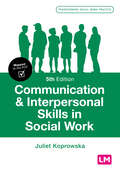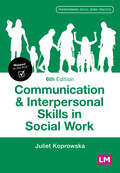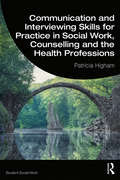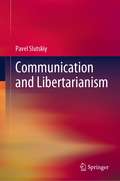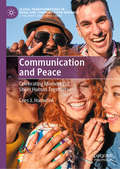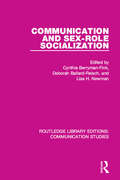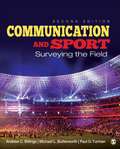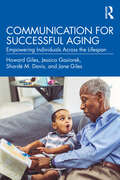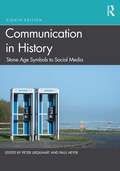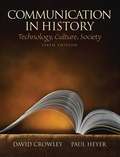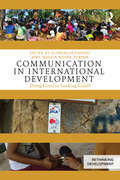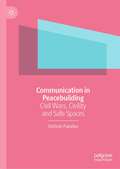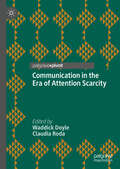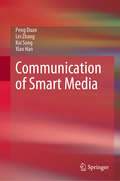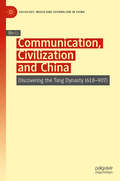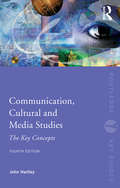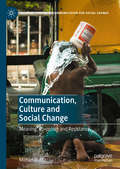- Table View
- List View
Communication and Interpersonal Skills in Social Work (Transforming Social Work Practice Series)
by Juliet KoprowskaCommunication and Interpersonal Skills in Social Work are at the heart of effective social work practice. This book offers students a solid grounding in the core knowledge and skills of communication needed for effective practice. The book takes the key theories in communication and explains them in a systematic and practice-related way, essential for both undergraduate and postgraduate students to develop a critical understanding of the subject. This crucial fifth edition supports students with core communication skills by providing in-depth coverage closely interwoven with learning features that engage, stimulate and challenge. Working with children, adults and those with learning difficulties are all fundamental aspects of the book making it useful to students of all disciplines.
Communication and Interpersonal Skills in Social Work (Transforming Social Work Practice Series)
by Juliet KoprowskaCommunication and interpersonal skills are an essential part of practice. Taking a skills-based approach, this book looks at research, theories, approaches and processes, demonstrating how they relate directly to practice. It will help you to understand the benefits that good communication skills can bring to your work with children and families, adults, groups, and those with communication difficulties.
Communication and Interpersonal Skills in Social Work (Transforming Social Work Practice Series)
by Juliet KoprowskaCommunication and interpersonal skills are an essential part of practice. Taking a skills-based approach, this book looks at research, theories, approaches and processes, demonstrating how they relate directly to practice. It will help you to understand the benefits that good communication skills can bring to your work with children and families, adults, groups, and those with communication difficulties.
Communication and Interviewing Skills for Practice in Social Work, Counselling and the Health Professions (Student Social Work)
by Patricia HighamThis book supports and develops the communication and interviewing skills of professional practitioners and student practitioners in social work, counselling, and the health professions. Combining work on personal and social constructs, the search for meaning, and ecological theory, this book both provides an integrated discussion of practice and presents a balanced approach when discussing psychological, biological, and social influences on individual well-being. Furthermore, it emphasises the influence of social contexts on behaviour and well-being, as well as valuing and encouraging the application of practitioners’ prior experience and learning (APEL) to new knowledge and understanding. Containing a range of practice examples to stimulate learning, this book promotes a collaboration between the professions, and welcomes the contributions of people who use services, patients, and clients. Communication and Interviewing Skills for Practice in Social Work, Counselling and the Health Professions will be of interest to all undergraduate and postgraduate social work students, as well as new and experienced professional health care practitioners.
Communication and Libertarianism
by Pavel Slutskiy"This is an outstanding contribution to both libertarian political philosophy and communication theory. It is far and away the most comprehensive work on communication issues in libertarian theory ever published. The author has integrated successfully the libertarian insights of Mises, Rothbard, Block, Kinsella and others with the philosophy of language as developed by Austin, Searle and Grice. He has done so in a unique and unprecedented way. The book would appeal to students and scholars interested in libertarian theory and more generally, to philosophers and political scientists interested in high-level scholarship.” - David Gordon, libertarian philosopher and intellectual historian, Ludwig von Mises Institute.
Communication and Peace: Celebrating Moments of Sheer Human Togetherness (Global Transformations in Media and Communication Research - A Palgrave and IAMCR Series)
by Cees J. HamelinkThis book provides a robust conceptualization of peace. Hamelink defines peace as conceived of moments of celebrating human togetherness, with deep fractures that polarize society standing in the way of collectively celebrating togetherness and posing a serious existential risk to humanity. ‘Deep dialogue’ is the form of human cooperative communication that is needed to build communities that can overcome polarization. This is the most difficult form of human conversation as it is based upon trust, mutuality, patience and freedom, and requires safe, non-threatening spaces, but this book explains how to overcome the essential obstacles that prevent this dialogue. To curate a ‘deep dialogue’ we must turn to humanity’s unique resource: our ability to communicate pro-socially and cooperatively.
Communication and Power in the Global Era: Orders and Borders (Shaping Inquiry in Culture, Communication and Media Studies)
by Marwan M. KraidyThis book re-visits how we think about communication and power in the global era. It takes stock of the last fifty years of scholarship, maps key patterns and concepts and sets an agenda for theory and research. The book addresses such questions as: How are national and cultural identities re-fashioned and expressed in the global era? How can we best understand the emergence of multiple and sometimes antagonistic modernities worldwide? How are political struggles fought and communicated on the local-national-global nexus? How do we integrate emerging media environments in global communication studies? Bringing together essays from a range of internationally renowned scholars, this book will be useful to undergraduate and postgraduate students on Media and Communication Studies courses, particularly those studying globalisation and global media. Contributors: Hector Amaya Paula Chakravartty Andrew Crocco Myria Georgiou Le Han Anikó Imre Koichi Iwabuchi Marwan M. Kraidy Sara Mourad Patrick D. Murphy Tarik Sabry Paddy Scannell Piotr M. Szpunar Guobin Yang Barbie Zelizer
Communication and Sex-role Socialization (Routledge Library Editions: Communication Studies #1)
by Cynthia Berryman-Fink Deborah Ballard-Reisch Lisa H. NewmanOriginally published in 1993. The essays in this book collectively seek to illuminate the role of communication and sex-role socialization throughout the life cycle. Section 1 addresses some important issues and behaviours that have an impact on the beginnings of the socialization process. Section 2 covers socialization later on in relationships, the workplace and the political arena while section 3 looks at manifestations of socialization through communication strategies and skills. Finally section 4 addresses ways to alter socialization through instructional practices in higher education. The approach to studying sex-role socialization varies by perspective and methodology and conclusions are interpreted in diverse ways but the results have been very similar and the research in this volume shows that the socialization of males and females continues to reinforce male dominance despite women’s advancement toward equal status in society. This work is of interest in the fields of sociology, psychology, anthropology and women’s studies as well as communication.
Communication and Sport: Surveying the Field, Second Edition
by Andrew C. Billings Michael L. Butterworth Paul D. TurmanThe Second Edition of Communication and Sport: Surveying the Field offers the most comprehensive and diverse approach to the study of communication and sport available at the undergraduate level. Newly expanded to incorporate the latest topics and perspectives in the field, the New Edition examines a wide array of topics to help readers understand important issues such as sports media, rhetoric, culture, and organizations from both micro- and macro- perspectives. Everything from youth to amateur to professional sports is addressed in terms of mythology, community, and identity; issues such as fan cultures, racial identity and gender in sports media, politics and nationality in sports, and sports and religion are explored in depth, and provide useful, applied insight for readers. Practical and relevant, epistemologically diverse, and theoretically grounded, the Second Edition of Billings, Butterworth, and Turman’s text keeps readers on the cutting-edge.
Communication and the Transformation of Economics: Essays in Information, Public Policy, and Political Economy (Critical Studies in Communication and in the Cultural Industries)
by Robert E Babe<p>Many governments are pursuing with relentless vigor a neoconservative/transnational corporate program of globalization, privatization, deregulation, cutbacks to social programs, and downsizing of the public sector. Countries are forming into giant “free trade” blocs. Increasingly they lack the will and desire to resist encroachments of world “superculture.” Furthermore, they encourage heightened commoditization of information and knowledge, for instance through stiffer intellectual property laws, through “Information Highway” initiatives, and through provisions in bilateral and multilateral trade treaties. The analytical underpinning and ideological justification for this neoconservative/transnational corporate policy agenda is mainstream (neoclassical) economics. <p>Focusing on the centrality of information/communication to economic and ecological processes, Communication and the Transformation of Economics cuts at the philosophical/ideological root of this neoconservative policy agenda. Mainstream economics assumes a commodity status for information, even though information is indivisible, subjective, shared, and intangible. Information, in other words, is quite ill-suited to commodity treatment. Likewise, neoclassicism posits communication as comprising merely acts of commodity exchange, thereby ignoring gift relations; dialogic interactions; the cumulative, transformative properties of all informational interchange; and the social or community context within which communicative action takes place. <p>Continuing in the tradition of writers such as Russel Wallace, Thorstein Veblen, Karl Polyani, E. F. Schumacher, Kenneth E. Boulding, and Herman Daly, Robert Babe proposes infusing mainstream economics with realistic and expansive conceptions of information/communication in order to better comprehend twenty-first-century issues and progress toward a more sustainable, more just, and more democratic economic/communicatory order.</p>
Communication as Culture, Revised Edition: Essays on Media and Society
by James W. CareyIn this classic text, James W. Carey maintains that communication is not merely the transmission of information; reminding the reader of the link between the words "communication" and "community," he broadens his definition to include the drawing-together of a people that is culture. In this context, Carey questions the American tradition of focusing only on mass communication's function as a means of social and political control, and makes a case for examining the content of a communication—the meaning of symbols, not only the motives that originate them or the purposes they serve. He seeks to recast the goal of communication studies, replacing the search for deterministic laws of behavior with a simpler, yet far more challenging mission: "to enlarge the human conversation by comprehending what others are saying." This new edition includes a new critical foreword by G. Stuart Adam that explains Carey's fundamental role in transforming the study of mass communication to include a cultural perspective and connects his classic essays with contemporary media issues and trends. This edition also adds a new, complete bibliography of all of Carey's writings.
Communication for Successful Aging: Empowering Individuals Across the Lifespan
by Jessica Gasiorek Howard Giles Shardé M. Davis Jane GilesThis essential volume explores the vital role of communication in the aging process and how this varies for different social groups and cultural communities. It reveals how communication can empower people in the process of aging, and that how we communicate about age is critically important to – and is at the heart of – aging successfully.Giles et al. confront the uncertainty and negativity surrounding "aging" – a process with which we all have to cope – by expertly placing communication at the core of the process. They address the need to avoid negative language, discuss the lifespan as an evolving adventure, and introduce a new theory of successful aging – the communication ecology model of successful aging (CEMSA). They explore the research on key topics including: age stereotypes, age identities, and messages of ageism; the role of culture, gender, ethnicity, and being a member of marginalized groups; the ingredients of intergenerational communication; depiction of aging and youth in the media; and how and why talk about death and dying can be instrumental in promoting control over life’s demands. Communication for Successful Aging is essential reading for graduate students of psychology, human development, gerontology, and communication, scholars in the social sciences, and all of us concerned with this complex academic and highly personal topic.
Communication in Cognitive Behavioral Therapy
by Michela RimondiniResearch has shown that the therapeutic alliance is a key factor in the success of treatment, and a critical component of establishing this alliance is the communication between therapist and client. The efficacy of treatment depends on the therapist's ability to collect reliable client information and create the foundation for a good relationship that involves the client in the healing process. Communication in Cognitive Behavioral Therapy provides an overview of the research and theory underlying the importance of therapeutic communication with a specific focus on cognitive behavioral psychotherapy. It brings together an international group of experts from the relevant disciplines of communication, psychotherapy, research and teaching to create an integrated perspective of this crucial area. The book offers a review of the main evidence-based theories, and is highlighted with specific examples and flow charts.Insight for trainers is given by providing learner-centered teaching methods that enhance the acquisition of these communication skills. For researchers, it offers both qualitative and quantitative analyses of the subject as well as a comprehensive review of the main analysis methods adopted in the field.
Communication in History: Stone Age Symbols to Social Media
by Paul Heyer Peter UrquhartThis updated eighth edition provides a thorough and engaging history of communication and media through a collection of essential, field-defining essays. The collection reveals how media has been influential in both maintaining social order and enabling social change. Contributions from a wide range of voices offer instructors the opportunity to customize their courses while challenging students to build upon their own knowledge and skill sets. From stone age symbols and early writing to the internet and social media, readers are introduced to an expansive, intellectually enlivening study of the relationship between human history and communication media. New case studies explore the Black Press, the impact of photography on journalism, gender and civil rights discourses in the media, and the effects of algorithmic data on modern social media platforms. This book can be used as a core text or supplemental reader for courses in communication history, communication theory, and introductory courses in communication and media studies.
Communication in History: Technology, Culture, Society (Sixth Edition)
by David Crowley Paul HeyerUpdated in a new 6th edition, Communication in History reveals how media has been influential in both maintaining social order and as powerful agents of change. With revised new readings, this anthology continues to be, as one reviewer wrote, "the only book in the sea of History of Mass Communication books that introduces readers to a more expansive, intellectually enlivening study of the relationship between human history and communication history". From print to the Internet, this book encompasses a wide-range of topics, that introduces readers to a more expansive, intellectually enlivening study of the relationship between human history and communication history.
Communication in International Development: Doing Good or Looking Good? (Rethinking Development)
by Jessica Noske-Turner Florencia EnghelInternational development stakeholders harness communication with two broad purposes: to do good, via communication for development and media assistance, and to communicate do-gooding, via public relations and information. This book unpacks various ways in which different efforts to do good are combined with attempts to look good, be it in the eyes of donor constituencies at large, or among more specific audiences, such as journalists or intra-agency decision-makers. Development communication studies have tended to focus primarily on interventions aimed at doing good among recipients, at the expense of examining the extent to which promotion and reputation management are elements of those practices. This book establishes the importance of interrogating the tensions generated by overlapping uses of communication to do good and to look good within international development cooperation. The book is a critical text for students and scholars in the areas of development communication and international development and will also appeal to practitioners working in international aid who are directly affected by the challenges of communicating for and about development.
Communication in Peacebuilding: Civil Wars, Civility and Safe Spaces
by Stefanie PukallusThis book is concerned with the role that communication - understood as including both the factual and fictional mass media as well as the performative and visual arts - can play in post-civil war peacebuilding. It engages with questions of how a society can move from the civil war conditions of discursive dehumanisation to peaceful cooperation in post-civil war settings and how peacebuilders can help communities utilise the transformative capacity of communication to encourage the reimagining of and engagement with former enemies as co-citizens. Ultimately, civil and peaceful cooperation depends on the observance of discursive civility and the building of safe discursive spaces in which civil engagement between different groups of society (including former combatants and survivors) can safely take place. This book argues that understanding communicative peacebuilding in this way is fundamental to the achievement of self-sustainable everyday peace.
Communication in a Civil Society
by Ruth Anna Abigail Shelley D. Lane John Casey GoochUsing the concept of “civility” as the major theme, this fully updated second edition offers a unique and alternative way to teach and learn about communication.The book brings together discrete areas that explore the fundamentals of communication and intrapersonal communication, interpersonal communication, small group communication, and public speaking. Every chapter includes theories, concepts, and examples that allow students to use civil and ethical communication skills in their personal relationships, in collaboration with colleagues, and in giving public speeches and professional presentations. This new edition highlights advances in and concepts related to mediated and technology-based communication, such as chatbots, technostress, and dating apps, and shows how students can engage in civil face-to-face and mediated interaction. Additionally, each chapter includes a real-world incident that students are asked to analyze in terms of specific chapter information and skills related to civility.Communication in a Civil Society is an ideal textbook for Introduction to Communication, Interpersonal Communication, and Public Speaking courses.Materials for instructors including PowerPoint slides, a test bank, and an instructor’s manual, are available at www.routledge.com/9781032513263.
Communication in the Era of Attention Scarcity
by Claudia Roda Waddick DoyleThis book examines a series of phenomena that have accompanied the development of digital technology and focuses on the attentional processes that these phenomena have in common. Across the social order, complaints are growing about a lack of attention as well as an overriding push by corporations and institutions to capture and mobilize attention. With a particular focus on social attention, the book highlights the need for an increased awareness about the agents that shape attention in our society, the effects that these agents (attempt to) produce, and the means by which individuals and groups may increase their control over personal and social attention. With a range of academic perspectives, this book is a crucial read for understanding the changing shape of political, business and personal communication.
Communication of Smart Media
by Lei Zhang Peng Duan Kai Song Xiao HanThis book provides the readers with an interdisciplinary perspective on communication in the diffuse boundaries that also demonstrates the diversity and inclusion for presenting wide range and rapid changes in contents, and the authors use “smart” as the guiding principle while indicate “communication” has been defined as a core feature. Appropriately, the book is divided into eight major sections. As always, the inevitable result of upgrading and constant iterations of developing new communication technology, the media communication has turned out to be one of the most important means in the smart era. The book sheds new light on virtual reality (VR), a pioneering technology in smart media communication, as an entry point to explore why the core social networks of smart news and smart media communication could occupy the central position in smart media communication while to discuss issues such as platform society built using smart media communication, and further elaborate on the integration of 5G technology, media and social transformation. This book not merely covers disciplines such as journalism and communication, but also on the universal application of smart media communication, and furthermore, it provides practical guidance and reviews cutting-edge ideas. It serves as a good future reference to help scholars, graduate students as well as relevant professionals for thinking outside the box that in order to continually expand reader’s knowledge and professional capabilities, especially aware of the impact of observation and judgment, value analysis and lifelong learning.
Communication, Civilization and China: Discovering the Tang Dynasty (618–907) (Sociology, Media and Journalism in China)
by Bin LiReferencing more than 40 ancient works as well as 70 books and papers of contemporary scholars, this book opens up the civilization, society, culture and communication of the Tang Dynasty. The Tang period represented unprecedented prosperity in the ancient world. Combining the socio-cultural background of ancient China and academic achievements of modern times, this book presents an intensive and in-depth exploration of the communicative organisations, methods and ideas of that period. The book looks at Tang methods of communication, from the postal delivery system and first newspaper to military communication in times of peace and war. It also considers questions of literature, poetry and public space as well as the impact of folk culture and communication on the Tang Dynasty, and examines the intellectual atmosphere of the time and debates surrounding freedom of speech and thought, positioning the Tang Dynasty as the end of the classic world and the beginning of modern society.
Communication, Cultural and Media Studies: The Key Concepts (Routledge Key Guides)
by John HartleyThis fourth edition of Communication, Cultural and Media Studies: The Key Concepts is an indispensible guide to the most important terms in the field. It offers clear explanations of the key concepts, exploring their origins, what they're used for and why they provoke discussion. The author provides a multi-disciplinary explanation and assessment of the key concepts, from 'authorship' to 'censorship'; 'creative industries' to 'network theory'; 'complexity' to 'visual culture'. The new edition of this classic text includes: Over 200 entries including 50 new entries All entries revised, rewritten and updated Coverage of recent developments in the field Insight into interactive media and the knowledge-based economy A fully updated bibliography with 400 items and suggestions for further reading throughout the text
Communication, Cultural and Media Studies: The Key Concepts (Routledge Key Guides)
by John HartleyNow in its fifth edition, this pioneering volume of Routledge’s ‘Key Concepts’ series offers clear explanations of key concepts, showing where they came from, what they are used for, and why they provoke discussion or disagreement. The new edition is extensively revised to keep pace with rapidly evolving developments in communication, culture and media, providing topical and authoritative guidance to transformational shifts from broadcast to digital technologies, national to global media and disciplinary to diverse knowledge. It includes: Nearly 250 entries, covering what and how to study across this multi-disciplinary field 50 new entries: from algorithm and assemblage, dance and data, to woke and worldbuilding Updated references with 500 items and suggestions for further reading Revisions, updates and examples throughout. For students and seasoned scholars alike, Communication, Cultural and Media Studies is an invaluable resource in an ever-changing landscape.
Communication, Culture and Ecology: Rethinking Sustainable Development in Asia (Communication, Culture and Change in Asia #6)
by Kiran PrasadThis book offers comprehensive insights into the cultural and ecological values that influence sustainable development across Asia, addressing the cultural, religious and philosophical moorings of development through participatory and grassroots communication approaches. It presents a range of contributions and case studies from leading experts in Asia to highlight the debates on environmental communication and sustainable development that are relevant today, and to provide an overview of the positive traditions of ecological sensitivity and cultural communication that may find common ground between communities. This well-researched guide to the dynamic and complex terrain of communication for sustainable development offers uniquely practical perspectives on communication, environment and sustainable development that are of immense value for policy makers, media scholars, development practitioners, researchers and students of communication and media studies.
Communication, Culture and Social Change: Meaning, Co-option and Resistance (Palgrave Studies in Communication for Social Change)
by Mohan DuttaDrawing on the culture-centered approach (CCA), this book re-imagines culture as a site for resisting the neocolonial framework of neoliberal governmentality. Culture emerged in the 20th Century as a conceptual tool for resisting the hegemony of West-centric interventions in development, disrupting the assumptions that form the basis of development. This turn to culture offered radical possibilities for decolonizing social change but in response, necolonial development institutions incorporated culture into their strategic framework while simultaneously deploying political and economic power to silence transformative threads. This rise of “culture as development” corresponded with the global rise of neo-liberal governmentality, incorporating culture as a tool for globally reproducing the logic of capital. Using examples of transformative social change interventions, this book emphasizes the role of culture as a site for resisting capitalism and imagining rights-based, sustainable and socialist futures. In particular, it attends to culture as the basis for socialist organizing in activist and party politics. In doing so, Culture, Participation and Social Change offers a framework of inter-linkage between Marxist analyses of capital and cultural analyses of colonialism. It concludes with an anti-colonial framework that re-imagines the academe as a site of activist interventions.
